This old Croatian football club has a good reputation among European football clubs. Its home town is the over 1700 year-old city Split with its over 300.000 inhabitants and a big sports tradition. Only few European towns and cities can compare to Split with such a tradition.
Already in early stage people in this city experienced or even influenced political changes through the sports very often. Sports always played an important role in the Dalmatian capitol. Split is also defined as one of the most sporting cities in Europe. Split proved that during the Mediterranean Sports Games in 1979 and in 1990 as the organizer of the European Championships in athletics. Split is also the hometown of Jugoplastika - a basketball team, which won the European Cup of National Champions twice and the Yugoslavian Championshipfive times. The golden generation of the " Zutih " (meaning " the yellow ones " - because of the club's colours) flattered his fans with legendary victories and sports triumphs. Players like Toni Kukoc ( NBA-Champion with Chicago Bulls ), Dino Rada ( former Boston-Celtics-player ), Zan Tabak ( NBA-Champion with Houston Rockets ) and many others made basketball history in Split. |


|
Writing the history of Split is impossible without mentioning its football history. The wonderful new stadium " Poljud " attracts crowds Sunday after Sunday, and since 1979 it has been the cult place of Hajduk fans. The heart of each Dalmatian beats for this club, for the goals, the victories and the success, which Hajduk players always shared with their fans. All this began on the " Royal Field " ( Kraljeva Njiva ), the " old place "( stari plac ) in 1911.
Well, it seemed as if it was easier for the founders of this Croatian traditional club to kick the ball than to find a suitable name for the club. The club was founded by four Croatian students ( Fabijan Kaliterna, Lucijan Stella, Ivan Sakic and Vjekoslav Ivanisevic ), who were studying in Prague at that time ( in 1911 ). They went to the football matches of Sparta and Slavia Prag regularly, and that's how they brought the round leather to Split. Without any warning, the whole bunch of them rushed into the office of Professor Barac at the University of Split, who was supposed to help them with finding a name for the club. They named it " Hajduk " - after the mystic heroes of the 16th and 17th century, who - like Robin Hood - held up rich strangers and gave the stolen goods to the poor people. Originally, the Hajduks were mercenaries, who were deployed by the Austrians/Hungarians in the fight against the Osmans ( Ottoman Empire ). |
In the first official match Hajduk Split beat the local Italian football club "Calcio" 9:0 ( 6:0 ). Sime Raunig scored the first goal with his knee. After every scored goal the town orchestra played in a song. That way the citizens of Split supported their club during the match.
Since the club's foundation on 13th of February 1911 many years went by, many goals have been scored, many unforgotten games have been played, many generations passed by. The club's white colour of the "Majstori s mora" (champions from the Adriatic Sea) inspired many players and fans. Game after game, victory after victory Hajduk Split held it's own among the European football clubs and that way earned international respect. Through the club's success the city Split became more and more famous. Many popular football players played for Hajduk. In 1924, the whole Hajduk team apart from the goalkeeper played in the national team. Hajduk's first goalkeeper that year was Italian. Hajduk Split is a living legend, whose players and trainers formed its history, like once Luka Kaliterna, who became a legend in his lifetime already. Internationally known players like Bernard Bajdo Vukas or Frane Matosic were very popular and wanted by several European teams during their active career.
In 1913, the first away match in Zagreb against HASK Zagreb ( now Dinamo ) followed, which Hajduk lost with 3:2. At that time played test- and friendly games improved not just the own ability of the players but also the financial situation of the new promoting club. |
In 1923, Hajduk played in the Royal Yugoslavian League ( at that time the Kingdom of Slovenians, Croatians and Serbians ), but didn't achieve any success worth mentioning. In the interest of the club, the people responsible for the city Split organized Hajduk's participation in an international tournament in South Africa. There, the Croatians achieved the big international breakthrough. During the tournament Hajduk won its first international match with 3:2 against Olympique Marseille, through which the club improved its image enormously. This unexpected success caused a real euphoria at home. At their arrival in the port of Split the team was waited for with a very friendly reception. From that time on, further development of the team and the coming games were the main topic in the Dalmatian metropolis. |
 |
 |
In 1927, Hajduk Split won the first championship, and for the first time of its history the club reached an international cup-tie. At that time the Champions League of today was called " Central European Cup of National Champions ". But already in the first round Hajduk Split had to face a hard opponent - the in those days very powerful Rapid Wien. The inexperienced Hajduk was beaten 8:1 in Austria, whereas in the return match Hjaduk lost 1:0 only.
The next title followed two years later. In 1929, the club won the championship again. That season Hajduk Split ended with remarkable statistics. The club had to take only one defeat during the whole football season. |
 |
In 1940/41, Hajduk won the first Croatian Championship. Unfortunately, it was the first and for a long time the last Croatian Championship, which Hajduk won with 31 points and a goal difference of 75:17.
In 1946, after the Second World War, Hajduk won the Championship again.
During the season 1948/49 the club went to Australia and thus was the first former Yugoslavian club, which has played on all five continents. |
The next championship was determined again in 1950. That time, Hajduk set up a league record, which hasn't been broken till today. During that season, the team from Split didn't loose a game although the stadium (stari plac) and the enclosed training area were under constructions and the team could train under aggravating conditions only. During this legendary season, the eldest European fan organisation " TORCIDA " was founded. And again they were students from Split, who founded Torcida on the 29th of September 1950. It was before the decisive match against the archenemy Red Star Belgrade.
It was before the decisive match against the archenemy Red Star Belgrade. This last game of that season in 1950 decided about the Yugoslavian Champion title. Both teams had equal number of points, although the goal difference was advantageous for Belgrade. Hajduk-fans followed their Brazilian example - the Torcida ( portug. Torcida / engl. Riot ) - who in 1950 during the World Championships in Brazil cheered on their national team from the first till the last minute of the game. The Brazilians dominated in these World Championships. They reached the finals and won the championship. Hajduk-fans decided to support their team in a way, in which nobody else ever did. They started moving a caravan consisting of few thousands fans from Zagreb. The whole town centre was euphoric. All of a sudden, over 20.000 spectators gathered during the match. Unfortunately, the stadium wasn't big enough, so many fans had to follow the game from outside. |
The Torcida changed the under-construction-stadium into a bubbling cauldron. Red Star Belgrade needed a draw to win the championship. Nevertheless, the guests' captain Rajko Mitic scored in the 31st minute of the game. The score of 1:0 lasted till the end of the first half. In the second half, Hajduk Split came much stronger. They assaulted the football ground, whereas the Torcida was cheering them up. In the 74th minute, the legendary Bernard Bajdo Vukas came into action. Running towards the opposing goal over the left side of the field he left one Belgrade player after another till he was standing face to face with the Belgrade goalkeeper Stankovic. He shot the round leather right in the corner of the goal - 1:1. The happiness of the Torcida was incredible, and the wave of euphoria and the strong wish to win was transferred to the football ground. |
 |
Frane Matosic, another Hajduk-legend and the team captain of Hajduk at that time, knocked down the Belgrade goalkeeper Stankovic after he had verbally attacked Matosic. But because of the fanatical spectators the uncertain referee didn't dare to send Matosic off the pitch. Hajduk Split carried on playing offensively and didn't stop putting pressure on the opponent. In the last minutes of the match, all Hajduk players apart from the tail ender were in the opposing field. In the 87th minute, the Croatians scored the decisive goal. After the ball bounced off, Bozo Broketa took the chance and kicked the ball from 30 meters distance towards the goal. Like a pull on a lead, the ball landed in the opponent's net - 2:1. The fans went crazy and the euphoric spectators ran on the pitch, which lead to interruption of the match. The game went on after few minutes. The Torcida celebrated its victory. After the long period of ten years Hajduk finally won the championship again and celebrated at the same time the 40th anniversary of the club. It was reason enough to organize a fete, which the city hasn't seen before.
But the events of this day had also their shady sides. Red Star Belgrade didn't want to accept the defeat and the lost championship, so together with the Belgrade government they worked on an "unfair intrigue". The powerful ideologue Milovan Dilas called in the Central Council of the Yugoslavian Communistic Party, so they could discuss the case. An executive committee was established to demonstrate the seriousness of the situation to the public. The presidency of Hajduk Split, Ante Jurjevic Baja and Jure Bilic, received a caution from the party. The climax of the plot was the exclusion of the team captain, Frane Matosic, who knocked down the goalkeeper Stankovic during the game. Some of the Torcida foundation members were politically persecuted and sent to jail. Vjenceslav Zuvela, one of the foundation members, was sentenced to jail for three years. The court of appeal reduced the sentence to three months. Like many other fans, he was reproached with wearing a " Torcida-Split " badge on his collar. The badge had the symbol of the fan-organization on it, which consisted of the letters "T" - standing for Torcida, and "H" - standing for Hajduk. The "Serbian brothers" though said the H was standing for "Hrvatska Torcida" - meaning the Croatian Torcida. ( Remark: Croatians supported the Germans and the Austrians during the 2nd World War! )
None of Hajduk-players would dare to change over to any of Belgrade's teams. Once, the legendary goalkeeper Vladimir Beara ignored this unwritten rule ( it was an order from Belgrade ). The street, which was named after him, was temporarily renamed into "the Street of Traitors", after Beara's change over. |


|
The next championship-victory was celebrated two years later, in 1952. Through the past success, the club became even more famous. The best-known players of that time - Bernard "Bajdo" Vukas, Vladimir Beara and Frane Matosic - had a good reputation even outside of Croatia.
In 1955, the Croatians won the next championship. Between 1956 and 1966 the Croatians came away empty-handed. In fact, they reached the Yugoslavian Championship finals three times, but they didn't succeed in the end.
Through the centralization of Yugoslavia, the state-owned clubs Red Star and Partizan Belgrade were privileged compared to the rest of the league. The state's political interference with football caused a big crisis among the other football clubs. But the " Majstori s mora " (Champions from the Adriatic Sea) never gave up hope and finally, in the season 1966/67 won a title in their unique way. They won the Yugoslavian Cup and for the first time they took part in the European Cup of Cup Winners. |
With breaks in between, like many others, Hajduk Split has been present on the European stage for 30 years, but the first European competition after the 2nd World War many Hajduk-fans still remember. In the first round of the European Cup of Cup Winners in 1967, Hajduk faced a strong opponent. They had to play against "Tottenham" from London. In the years to come, it was Hajduk's competitor who they had to fear. In Split, Tottenham beat Hajduk 2:0, whereas after the exciting game on the islands Hajduk had to be pleased with the result of 4:3 for Tottenham. |
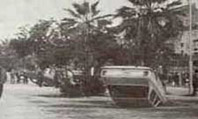 |
At the beginning of the 70ies ( 1971 ) Croatia went through a hard, political time. Arresting, persecutions and maltreatation took place. Already at that time, Croatia was aiming independency for the republic and the separation from the Yugoslavian confederation. These political changes had consequences for the Torcida as well as for the club Hajduk Split. The central government of Belgrade ordered to replace the already mentioned red-white squares-pattern of Croatia in Hajduk's emblem with the red communistic star. The Torcida was banned, so further actions under the name of Torcida were officially not possible any more. The hard middle of Hajduk-fans reorganized itself under the pseudonym "The Uncompromising" and didn't want to submit to the government that easy. |
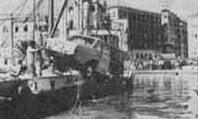 |
In the 70ies, the Torcida committed itself to prevent the interference of the Belgrade politicians into the club's affairs. Participation in action of the Torcida before every competition with the main Serbian clubs ( OFK, Red Star and Partizan Belgrade ) became the highest duty of Hajduk-fans. Besides that, Hajduk's players were hardly taken into consideration for the national team. For these reasons, it was good form to fight with the Red Star - and Partizan-fans.
During the season 1970/71 Split again was the king of football. Hajduk had to wait 16 long years till they could present a champion title to their fans. That year again, the vivacious inhabitants of Split waited for Hajduk Split with a great reception. The whole town was on its feet and came together on the bank promenade of the town centre to welcome the new champions. In the following year, Hajduk dominated the Yugoslavian league again. Already in the season 1973/74 the team did the double and won the championship as well as the cup. This success was repeated in the next season ( 1974/75 ). From 1972 till 1976, Hajduk won the Yugoslavian Cup each year. This record still exists today. |
From the season 1970/71 till the middle of the 80ies, Hajduk could look down on its most successful player's generation. In all those years, the Croatians achieved the best results of the club's history, especially in the European competitions - UEFA-Cup, European Cup of the national champions and the European Cup of Cup Winners. Through the support of Torcida even the most difficult games could be won and the alleged opponents were beaten. Even in dramatic last minutes of important matches, Hajduk often turned the table and won. Many great clubs like Leeds United, Hamburger SV, AC Turin, St. Etienne, VFB Stuttgart, FC Valencia, FC Metz and Sparta Prague were beaten in Split. Football in Split cast a spell on the crowds in the direct competitions with the greatest European teams. |
European Cup of Cup Winners - three times, the Croatians reached the quarterfinals. Last time, in 1995, in the new Champions League they were eliminated by the later Cup winner Ajax Amsterdam with 0:0/0:3. In 1976, PSV Einhoven won against Hajduk 2:0 and 0:3, and 1980, Hamburger SV beat Hajduk 3:2 and 0:1. European Cup of Cup Winners - in 1973, Hajduk experienced the greatest success when they narrowly lost in the semi-finals. At the end, Hajduk scored only one goal too less to enter the finals. And again, it was an English team the Croatian traditional club lost against - it was Leeds United who won 0:0 and 1:0.
UEFA-Cup - Hajduk Split is the most successful club from former Yugoslavia in this competition. The greatest success in the UEFA-Cup Hajduk achieved in 1984 when they reached the semi-finals. There again, they lost against an English team. That time it were the Tottenham Hotspurs, who reached the finals with 2:1 and 0:1. |

|
In 1979, constructions of the today's stadium "Poljud" were completed. The stadium gives place to 35.000 spectators, and because of its location and its form ( the stadium is placed right at the sea and has the form of a shell ) it is Croatia's most beautiful stadium and one of the most beautiful stadiums in Europe. It was built in 1979 because of the organization of the Mediterranean festival games and became very soon the new home of Hajduk, its fans, the won cups and new triumphs. That year, Hajduk won the Championship again.
It wouldn't be Croatian history, if the success developed consistently without any resistance. The front lines of symbolic and actual wars traditionally foiled Hajduk's history more than the history of any other club in this region. In this boasting club it was mostly clear early how the wind changed at Dalmatia's coasts. Long time before Croatia's proclamation of independence in October 1989, Torcida demonstrated impressively what else people in Croatia thought about the "Yugoslavian idea". Yugoslavian national flags were burned and Partizan Belgrade-fans were beaten in the Poljud-stadium during the last game of this season. The match had to be interrupted with the score at 2:0. |
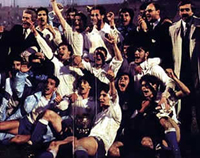 |
In the season 1990/91, the strategist Aljosa Asanovic lead his team to a grandiose victory in the last Yugoslavian Cup finals in Belgrade. Hajduk won against Red Star Belgrade through a goal by Alen Boksic with 1:0. The handling out of the trophy, by rights the property of the Yugoslavian football association, has been successfully denied so far. The cup is placed on the shelves in the clubhouse as a memorial of a last triumph of the Croatian football club over the Belgrade team.
Asanovic changed over to Cannes ( France ) and missed the wildest time of the club. It was the time period, when plastic bags became money cases and every fax-machine owner was passed for a serious football-player agent. The half of the dream-team left the club at that time - with Alen Boksic also went: Robert Jarni, Nicola Jerkan, Tonci Gabric, Aljosa Asanovic and others. The estimate 10 millions from the transfers which could be snatched away from the hands of the dealers made it possible for Hajduk to survive as a big club. |
On the 17th of October 1990, the split-off was anticipated with two international matches played at the same time. The Serbian dominated national team of Yugoslavia played against Northern Ireland in Belgrade, and the Croatian representative team with many Hajduk-players met a team from the USA in Zagreb ( 2:0 ).
In 1992, the first aggressions and attacks by the Serbian army to Croatia took place. Many members of Torcida voluntarily went to this war, but also members of other Croatian clubs went the same way. In honour of all the killed Hajduk-fans, who gave their lives for Croatia's freedom and independence a monument was built in the Poljud-stadium below the fan-block - Sjever ( north corner ), entrance " M ".
Bombs destroyed several Croatian towns and cities and therefore also their stadiums. Because of those aggressions the Yugoslavian national team was suspended from the coming European Championships 1992, and Denmark moved up in the tournament. Surprisingly, the Danes won the European Championships ' 92. The Croatian players carried on training and could hardly wait for the historical start of their first own team. While several tows were still being bombed, the decision was made - football should go on. Some teams couldn't take part properly in the championships not to mention to train decently. The attacks expanded to Osjiek, Zadar, Sibenik, Dubrovnik, Vukovar, Vinkovac and other Croatian towns and cities. The first championship started with 12 teams. The dates for the games were set quicker than usual, so the regular football activities took place Tuesdays and Saturdays. Hajduk Split came up again to the reputation as " Majstori s mora ( champions from the Adriatic sea ) ". The first historical championship went to Split. There were no doubts; Hajduk was simply the best Croatian team. |
In the season 1992/93, Hajduk became the Croatian Cup Winner and in 1993/94 again national champion. As the representative of the national champion resp. Cup winner, Hajduk also won the Super Cup in 1992, 1993 and 1994. In the season 1994/95 Hajduk did the double. They won the Championship and the Cup, and therefore also the Super Cup 1995 ( Super Cup-winner 1992-1995 ). This season was registered in the annals as the most successful season of the club.
The club's management " played poker " before the beginning of the season. They fetched back former Hajduk-players from abroad for 2 million Deutschmarks. They gained back experienced professionals like the tall marker Igor Stimac, who had just been relegated with Cadiz ( Spain ), the strategist Aljosa Asanovic - at last in Montpellier, the libero Zoran Vulic from FC Nantes, the former junior player Stjepan Andrijasevic who was lent to Celta Vigo and last but not least the goalkeeper Tonci Gabric who was sent some team-photos of the club PAOK with a hole in his forehead by Serbian emigrants in Saloniki (Greece). That's how Hajduk's head brought together five top performers. Out of them and out of other young talents from the region, the couch Ivan Katalinic composed a team, which was full of modern football strategies and which was cheered up standing a good chance of success. It seemed to be the right combination, because the success wasn't long in coming. In 1995, the club won all national titles possible ( to be won ), whereas in the new-formed Champions League they reached the quarterfinals. There, they lost against the following national champion Ajax Amsterdam with 0:0 and 3:0.
Hajduk Split was always able to fight its way through with its potentials in Europe. But because of the ongoing sale of the own talents the great success on the European level stayed away. Hajduk was never able to bring out a long-term, real, young and experienced team, because the best young players were often sold to the European top teams (e.g. Aljosa Asanovic, Alen Boksic, Robert Jarni, Igor Stimac, Slaven Bilic, Igor Tudor and many others). This inexperience cost Hajduk Split its leap to the European football leaders. The best example is the bogy team Tottenham Hotspurs who the Croatians faced three times and who they were eliminated by three times. |
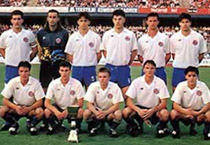
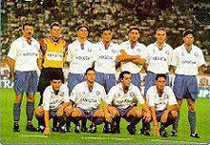
|
Hajduk Split is the big love of every citizen of Split, in the whole region Dalmatia and - above that - worldwide. Hajduk isn't just a famous football club but the symbol of the city Split. To a great extent, it's due to Hajduk that the city became famous worldwide. Every town and city has its own history. Split's history can be begun with Hajduk, but that hi-story - like every true story - doesn't have an ending. How could it end if ...
Hajduk lives forever ... TORCIDA
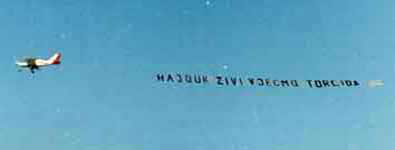
|
|